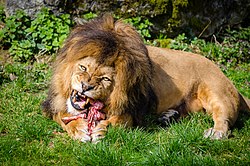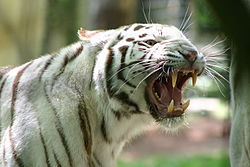Carnivore

A carnivore /ˈkɑːrnɪvɔːr/, or meat-eater (Latin, caro, genitive carnis, meaning meat or "flesh" and vorare meaning "to devour"), is an animal or plant whose nutrition and energy requirements are met by consumption of animal tissues (mainly muscle, fat and other soft tissues) as food, whether through predation or scavenging.[1][2]
Nomenclature
Mammal order
The technical term for mammals in the order Carnivora is carnivoran, and they are so-named because most member species in the group have a carnivorous diet, but the similarity of the name of the order and the name of the diet causes confusion.
Many but not all carnivorans are meat eaters; a few, such as the
Dietary carnivory is not a distinguishing trait of the
Carnivorous diet
Animals that depend solely on animal flesh for their nutrient requirements in nature are called

Outside the animal kingdom, there are several genera containing
Subcategories of carnivory
Carnivores are sometimes characterized by their type of prey. For example, animals that eat mainly insects and similar terrestrial arthropods are called insectivores, while those that eat mainly soft-bodied invertebrates are called vermivores. Those that eat mainly fish are called piscivores.
Carnivores may alternatively be classified according to the percentage of meat in their diet. The diet of a
Omnivores also consume both animal and non-animal food, and apart from their more general definition, there is no clearly defined ratio of plant vs. animal material that distinguishes a facultative carnivore from an omnivore.[6]
Obligate carnivores


Obligate or "true" carnivores are those whose diet requires nutrients found only in animal flesh in the wild. While obligate carnivores might be able to
Obligate carnivores are diverse. The amphibian
Characteristics of carnivores
Characteristics commonly associated with carnivores include strength, speed, and keen senses for hunting, as well as teeth and claws for capturing and tearing prey. However, some carnivores do not hunt and are scavengers, lacking the physical characteristics to bring down prey; in addition, most hunting carnivores will scavenge when the opportunity arises. Carnivores have comparatively short digestive systems, as they are not required to break down the tough cellulose found in plants.
Many hunting animals have evolved eyes facing forward, enabling depth perception. This is almost universal among mammalian predators, while most reptile and amphibian predators have eyes facing sideways.
Prehistory of carnivory
Proterozoic origin
The earliest predators were microorganisms, which engulfed and "swallowed" other smaller cells (i.e. phagocytosis) and digested them internally. Because the earliest fossil record is poor, these first predators could date back anywhere between 1 and over 2.7 bya (billion years ago).[10]
The rise of
The sudden disappearance of the precambrian Ediacaran biota at the end-Ediacaran extinction, who were mostly bottom-dwelling filter feeders and grazers, has been hypothetized to be partly caused by increased predation by newer animals with hardened skeleton and mouthparts.[11]
Paleozoic
The degradation of
The first
The dominance of temnospondyls around the wetland habitats throughout the
Mesozoic
In the
Though the theropods were the larger carnivores, several carnivorous mammal groups were already present. Most notable are the
Cenozoic
In the early-to-mid-Cenozoic, the dominant predator forms were mammals:
Most carnivorous mammals, from
See also
References
- ^ Ullrey, Duane E. "Nutrient". Encyclopedia of Animal Science.
- ^ a b Ullrey, Duane E. "Carnivores". Encyclopedia of Animal Science. Mammals.
- ^ "What do pandas eat?". panda.org. World Wide Fund for Nature. Retrieved 6 December 2021.
- )
- ^ "Crocodiles in Zimbabwe fed vegetarian diet to make better handbags". The Telegraph. 8 April 2014. Retrieved 6 April 2024.
- ^ Ullrey, Duane E. "Omnivores". Encyclopedia of Animal Science. Mammals.
- ^
Armstrong, P. Jane; Gross, Kathy L.; Becvarova, Iveta; Debraekeleer, Jacques (2010). "Introduction to Feeding Normal Cats" (PDF). Small Animal Clinical Nutrition. pp. 371–372. Archived (PDF) from the original on 12 May 2021. Retrieved 17 January 2022.
Because grass is not digested within the cat's gastrointestinal (GI) tract, it acts as a local irritant and sometimes stimulates vomiting. Thus, grass eating may serve as a purgative to eliminate hair or other indigestible material.
- ^
Velegrand-Defretin, Veronique (1994). "Differences between cats and dogs: A nutritional view". Proceedings of the Nutrition Society. 53 (1): 15–24. PMID 8029223.
- ^
Ullrey, D.E. (2004). "Carnivores". In Pond, Wilson (ed.). Encyclopedia of Animal Science. Mammals. CRC Press. p. 591. ISBN 978-0-8247-5496-9.
Ullrey, D.E. (2004). "Nutrient requirements: Carnivores". Encyclopedia of Animal Science. CRC Press. p. 670.ISBN 9780824754969. - ^ a b Bengtson, Stefan (October 2002). "Origins and early evolution of predation" (PDF). The Paleontological Society Papers. 8. Cambridge University Press: 289–318. (PDF) from the original on 10 September 2008.
- PMID 16592084.
- ^ a b
Sahney, S.; Benton, M.J.; Falcon-Lang, H.J. (2010). "Rainforest collapse triggered Pennsylvanian tetrapod diversification in Euramerica". Geology. 38 (12): 1079–1082. doi:10.1130/G31182.1.
- ^ Foley, James A. (7 February 2014). "Carnivorous, pre-dinosaur predator was first to evolve steak knife-like teeth". Nature World News. Retrieved 3 May 2014.
- ^ a b
Kielan-Jaworowska, Zofia; Cifelli, Richard L.; Luo, Zhe-Xi (2004). "Chapter 12: Metatherians". Mammals from the Age of Dinosaurs: Origins, evolution, and structure. New York, NY: Columbia University Press. pp. 425–262. ISBN 0-231-11918-6.
- ^ Fox, Richard C. (2015). "A revision of the late Cretaceous–Paleocene eutherian mammal Cimolestes (Marsh, 1889)". Canadian Journal of Earth Sciences. 52 (12): 1137–1149. .
- ^ Cifelli, Richard L.; Madsen, Scott K. (1998). "Triconodont mammals from the medial Cretaceous of Utah". Journal of Vertebrate Paleontology. 18 (2): 403–411. .
- ^ de Muizon, Christian; Lange-Badré, Brigitte (1997). "Carnivorous dental adaptations in tribosphenic mammals and phylogenetic reconstruction". .
- ^ "Animales carnivoros. Ejemplos, alimentacion y curiosidades". Que Come (in Spanish). Eating Encyclopedia. 2 February 2017. Archived from the original on 24 February 2019.
Further reading
- Glen, Alistair & Dickman, Christopher, eds. (2014). Carnivores of Australia. Melbourne, AU: CSIRO Publishing. ISBN 978-0-643-10310-8.
